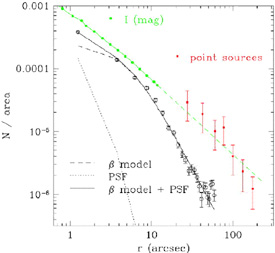


4.2. X-ray sources and Globular Clusters
The association of X-ray sources in early type-galaxies with GCs has been
widely discussed. As can be seen from
Table 1, associations with GCs
range from  10% in most
galaxies, ~ 40% in some Virgo galaxies (NGC 4472, NGC 4649), to 70% in NGC 1399, the dominant galaxy in a group . The
statistics are somewhat fraught with uncertainty, since lists of GCs from
HST are not available for all the galaxies studied with
Chandra, and the detection thresholds differ in different
galaxies. However, this association is interesting and has led to the
suggestion that perhaps all the LMXBs in early-type galaxies may form in
GCs, from whence they may be expelled if they receive strong enough
kicks at their formation, or may be left behind if the GC is tidally
disrupted. This suggestion was first advanced by
Sarazin, Irwin &
Bregman (2000),
and was more recently elaborated by
White, Sarazin &
Kulkarni (2002),
on the basis of a correlation of the specific
GC frequency with the ratio of the integrated LMXB luminosity
to the optical luminosity of eleven galaxies.
Kundu, Maccarone &
Zepf (2002)
explore the LMXB-GC connection in NGC 4472, where
they find that 40% of the sources detected at
LX > 1 × 1037 ergs s-1
are associated with GCs. In this galaxy, the fraction of GCs hosting an
X-ray source is 4%, the same as in the Galaxy and M31. More luminous,
more metal rich, and more centrally located GCs are more likely to host
LMXBs, reflecting both an increased probability of binary formation with
the numbers of stars in a GC, and also an effect of metallicity in
aiding binary formation
(Kundu, Maccarone &
Zepf 2002).
10% in most
galaxies, ~ 40% in some Virgo galaxies (NGC 4472, NGC 4649), to 70% in NGC 1399, the dominant galaxy in a group . The
statistics are somewhat fraught with uncertainty, since lists of GCs from
HST are not available for all the galaxies studied with
Chandra, and the detection thresholds differ in different
galaxies. However, this association is interesting and has led to the
suggestion that perhaps all the LMXBs in early-type galaxies may form in
GCs, from whence they may be expelled if they receive strong enough
kicks at their formation, or may be left behind if the GC is tidally
disrupted. This suggestion was first advanced by
Sarazin, Irwin &
Bregman (2000),
and was more recently elaborated by
White, Sarazin &
Kulkarni (2002),
on the basis of a correlation of the specific
GC frequency with the ratio of the integrated LMXB luminosity
to the optical luminosity of eleven galaxies.
Kundu, Maccarone &
Zepf (2002)
explore the LMXB-GC connection in NGC 4472, where
they find that 40% of the sources detected at
LX > 1 × 1037 ergs s-1
are associated with GCs. In this galaxy, the fraction of GCs hosting an
X-ray source is 4%, the same as in the Galaxy and M31. More luminous,
more metal rich, and more centrally located GCs are more likely to host
LMXBs, reflecting both an increased probability of binary formation with
the numbers of stars in a GC, and also an effect of metallicity in
aiding binary formation
(Kundu, Maccarone &
Zepf 2002).
While the possibility of LMXB formation in GCs is intriguing, this is still an open question, since evolution of bulge stars may also produce LMXBs (e.g., Kalogera & Webbink 1998; Kalogera 1998). The spatial distribution of the LMXBs, if it follows the optical stellar light (e.g. in NGC 1316, Kim & Fabbiano 2003; Fig. 12), would be consistent with this hypothesis. However, in NGC 4472 at least, no differences are found in the distributions of X-ray luminosities of the GC sources and the other LMXBs (Maccarone, Kundu & Zepf 2003). Moreover, in the inner bulge of M31, at radii that even with Chandra cannot be explored in elliptical galaxies because of their distances, the distribution of LMXBs appears more peaked than that of the optical light (Kaaret 2002).
 |
Figure 12. Radial distributions of the emission components of NGC 1316. The gaseous component (hot ISM) is represented by the inner distribution of points. The cumulative XRB contribution is given by the outer set of points; the dashed line through these points is the extrapolation of the stellar (I) surface brightness (Kim & Fabbiano 2003). |